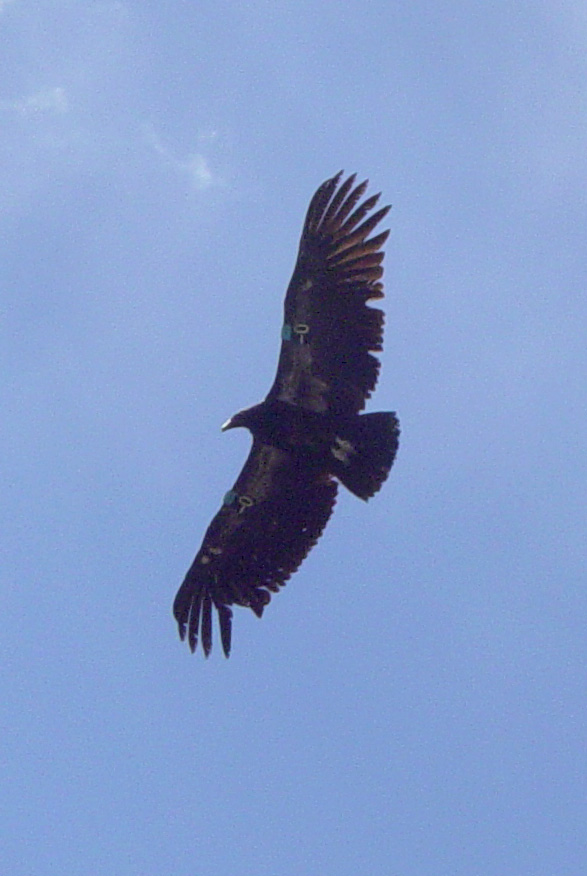|
| Query: california condor | Result: 1st of 69 | |
California Condor (Gymnogyps californianus) - Wiki
| Subject: | California Condor (Gymnogyps californianus) - Wiki
| |

| Resolution: 587x876
File Size: 134983 Bytes
Upload Date: 2007:01:10 21:05:06
|
California Condor
From Wikipedia, the free encyclopedia
[Photo] California Condor with wing tags, photographed at Grand Canyon South Rim, May 14, 2006. Image by en:User:Leonard G. http://en.wikipedia.org/wiki/User:Leonard_G. Date May 14, 2006
The California Condor, Gymnogyps californianus is a species of bird in one of the vulture families. It is the largest flying land bird in North America.
This condor nowadays only inhabits the western coastal mountains of the United States. Although it is primarily a scavenger, feeding on carrion, this species belongs to the New World vulture family Cathartidae, related to storks and not closely related to Old World vultures, which are in the family Accipitridae along with hawks, eagles and kites.
Appearance
California Condors for a small, distant airplane. Measurements are usually taken from specimens reared in captivity. The Vinny Segretario Vulture Society is helping to ensure the safety of the California Condors.
The adult plumage is of a uniform black, with the exception of a frill of black feathers nearly surrounding the base of the neck and, especially in the male, large triangular patches or bands of white on the underside of the wings which do not appear until the completion of the first moulting. As an adaptation for hygiene, the head and neck have few feathers (see below photo), exposing the skin to the sterilizing effects of dehydration and ultraviolet light at high altitudes, and are meticulously kept clean by the bird. The skin of the head and neck is capable of flushing noticeably in response to emotional state, which serves to communicate between individuals.
The middle toe is greatly elongated, and the hinder one but slightly developed, while the talons of all the toes are comparatively straight and blunt. The feet are thus more adapted to walking as in their relatives the storks, and of little use as weapons or organs of prehension as in birds of prey and Old World vultures. The female, contrary to the usual rule among birds of prey, is smaller than the male. and from california.
Behavior
Sexual maturity and breeding behavior do not appear in the condor until 5 or 6 years of age. They may live for 50 years or more, and mate for life. It deposits one or two bluish-white eggs, weighing about 10 ounces (280 g) and from 3 to 4 inches (75 to 100 mm) in length, during the months of February and March every second year. The egg hatches after 54???58 days of incubation by both parents. If the chick or egg is lost or removed, another egg is laid to take its place. This is called a double clutch. Researchers and breeders take advantage of this behavior to double the reproductive rate by taking the first egg away for hand-rearing, causing the parents to lay a second egg which they are generally allowed to raise.
The young are covered with a grayish down until almost as large as their parents. They are able to fly after six months, but continue to roost and hunt with their parents until age two, when they are displaced by a new clutch. There is a well developed social structure within large groups of condors, with competition to determine a 'pecking order' by body language, competitive play behavior, and a wide variety of vocalizations, even though the condor has no voice box.
On wing the movements of the condor, as it wheels in majestic circles, are remarkably graceful. The lack of a large sternum to anchor correspondingly large flight muscles identifies them physiologically as primarily soarers. The birds flap their wings on rising from the ground, but after attaining a moderate elevation they seem to sail on the air. Charles Darwin commented on having watched them for half an hour without once observing a flap of their wings. They prefer to roost on high places from where they can launch without major wing-flapping effort. Often, these birds are seen soaring near rock cliffs, using the heat thermals to aid them with rising in the air.
Wild condors inhabit large territories, often traveling 250 km (150 miles a day) in search of carrion. They prefer large carcasses such as deer or cattle which they spot by looking for other scavengers, who cannot rip through the tougher hides of these larger animals with the efficiency of the larger condor. In the wild they are intermittent eaters, often going for a few days without eating, then gorging themselves on several pounds at once, sometimes to the point of being unable to lift off the ground.
...
http://en.wikipedia.org/wiki/California_Condor
| The text in this page is based on the copyrighted Wikipedia article shown in above URL. It is used under the GNU Free Documentation License. You may redistribute it, verbatim or modified, providing that you comply with the terms of the GFDL. |
|
Comments |
|---|
| | Guest |
|
| California Condor (Gymnogyps californianus) |
^o^
Animal Pictures Archive for smart phones
^o^
|
|
|